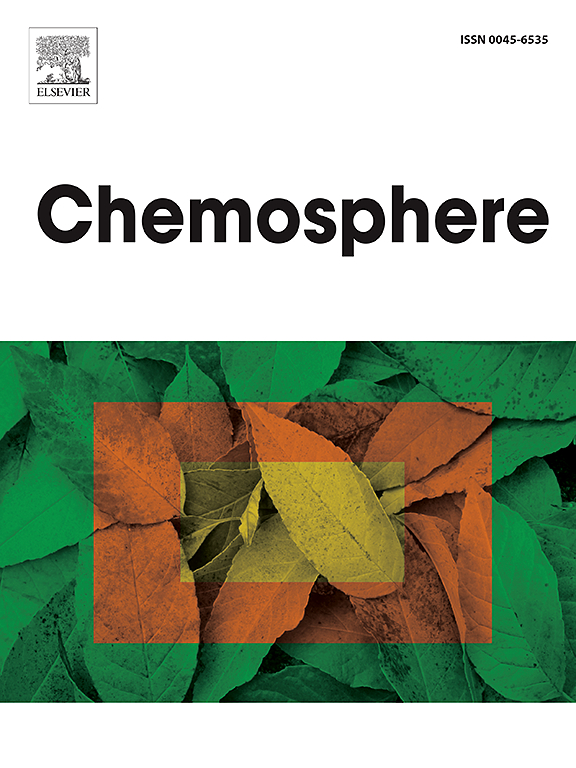Competitive adsorption and molecular interaction study of sulfamethoxazole and trimethoprim on biomass-based activated carbon
IF 8.1
2区 环境科学与生态学
Q1 ENVIRONMENTAL SCIENCES
引用次数: 0
Abstract
This study investigated the adsorption of sulfamethoxazole and trimethoprim onto activated carbon from reed canary grass in single- and binary-solute systems. Trimethoprim showed higher adsorption capacity than sulfamethoxazole. Single solute adsorption isotherms were modeled using Nitta model to assess equilibrium and site energy. The adsorption of trimethoprim and sulfamethoxazole followed a monolayer pattern, with trimethoprim exhibiting a higher maximum adsorption capacity (0.69 mmol/g) compared to sulfamethoxazole (0.55 mmol/g). Trimethoprim also demonstrated a significantly greater adsorption affinity (521.89 L/mmol) than sulfamethoxazole (70.92 L/mmol). The ratio of adsorption sites occupied to adsorbed molecules was 0.81. Weighted mean of site energy was 11.5 kJ/mol for sulfamethoxazole and 16.7 kJ/mol for trimethoprim, suggesting stronger trimethoprim interactions. Competitive adsorption experiments showed that trimethoprim significantly reduced sulfamethoxazole adsorption due to its stronger interaction with the adsorbent and its larger molecular size, which blocked small pores and shielded the adsorbent surface, restricting sulfamethoxazole access to adsorption sites. In the binary-solute system, the maximum adsorption capacity increased to 0.93 mmol/g, surpassing the individual maximum capacities of sulfamethoxazole and trimethoprim in their single-solute systems. However, the adsorption affinities of sulfamethoxazole and trimethoprim during competitive adsorption, at 9.29 and 267.69 L/mmol respectively, were lower than their corresponding values in single-solute solutions. Scanning transmission X-ray microscopy combined with X-ray absorption near-edge structure spectroscopy revealed adsorption mechanisms of sulfamethoxazole on activated carbon. The aromatic C![]() C peak shifted from 285.7 to 285.2 eV, indicating π–π electron donor-acceptor interaction. The carboxylic carbon peak at 288.1 eV increased in intensity, suggesting n–π interaction.
C peak shifted from 285.7 to 285.2 eV, indicating π–π electron donor-acceptor interaction. The carboxylic carbon peak at 288.1 eV increased in intensity, suggesting n–π interaction.

磺胺甲恶唑和甲氧苄啶在生物质活性炭上的竞争吸附及分子相互作用研究
研究了芦苇草活性炭在单溶质和双溶质体系中对磺胺甲恶唑和甲氧苄啶的吸附性能。甲氧苄啶的吸附量高于磺胺甲恶唑。采用Nitta模型对单溶质吸附等温线进行建模,以评估平衡态和位能。甲氧苄啶和磺胺甲恶唑的吸附呈单层模式,甲氧苄啶的最大吸附量为0.69 mmol/g,磺胺甲恶唑的最大吸附量为0.55 mmol/g。甲氧苄啶的吸附亲和力(521.89 L/mmol)显著高于磺胺甲恶唑(70.92 L/mmol)。吸附位置与吸附分子的比值为0.81。磺胺甲恶唑的加权平均位能为11.5 kJ/mol,甲氧苄啶的加权平均位能为16.7 kJ/mol,表明甲氧苄啶的相互作用更强。竞争吸附实验表明,甲氧苄氨嘧啶与吸附剂的相互作用较强,其分子尺寸较大,堵塞了吸附剂表面的小孔隙,屏蔽了吸附剂表面,限制了磺胺甲恶唑进入吸附位点,从而显著降低了对磺胺甲恶唑的吸附。在二元溶质体系中,最大吸附量增加到0.93 mmol/g,超过了磺胺甲恶唑和甲氧苄啶在单溶质体系中的最大吸附量。而在竞争吸附过程中,磺胺甲恶唑和甲氧苄啶的吸附亲和度分别为9.29和267.69 L/mmol,低于其在单溶质溶液中的对应值。扫描透射x射线显微镜结合x射线吸收近边结构光谱揭示了磺胺甲恶唑在活性炭上的吸附机理。芳香族CC峰由285.7 eV移至285.2 eV,表明π -π电子给体-受体相互作用。288.1 eV的羧基碳峰强度增大,表明存在n -π相互作用。
本文章由计算机程序翻译,如有差异,请以英文原文为准。
求助全文
约1分钟内获得全文
求助全文
来源期刊

Chemosphere
环境科学-环境科学
CiteScore
15.80
自引率
8.00%
发文量
4975
审稿时长
3.4 months
期刊介绍:
Chemosphere, being an international multidisciplinary journal, is dedicated to publishing original communications and review articles on chemicals in the environment. The scope covers a wide range of topics, including the identification, quantification, behavior, fate, toxicology, treatment, and remediation of chemicals in the bio-, hydro-, litho-, and atmosphere, ensuring the broad dissemination of research in this field.
 求助内容:
求助内容: 应助结果提醒方式:
应助结果提醒方式:


